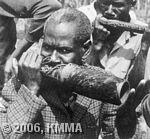Back
Ikondera





Ikondera is the generic name for an instrumental ensemble made up of five different
types of horns, umurangi, incuragane, urugunda, inkanka and
insengo, as well as two types of drums, ruharage
and ingaraba. The origin
of this ensemble may not be Burundese (see also the Rwandan equivalent
Amakondera).
The various types of horns all have the same basic structure: a piece of bamboo 35-50 mm in
diameter with an oval or rectangular mouthpiece on the side, an open reed at one end, which
when covered produces a second note, and at the other end a gourd serving as a resonator
(except on the insengo and the urugunda), often covered with an animal skin.
Despite the fact that neither the length nor the diameter are standardised, five distinct
types can be identified:
-
The umurangi is played by the leader of the ensemble, who introduces the music
(the name of the instrument can be translated as ‘he who introduces’) and has a role as
soloist. Usually there is just one umurangi in each ensemble and it is also the
biggest type of horn (40-54 cm).
-
The incuragane means ‘instrument with the quick notes’. This horn is 35 cm in size
on average and has an opening in the form of a reed tube at the end where the blowhole is
located. By covering this with the thumb a second note can be produced. There are usually
two incuragane in the ensemble and they are the second most important instrument after
the umurangi.
-
The urugunda is the ‘regular voice’ and is the third most important component in the
ensemble. Musically it has a bass function. There are usually two horns of this type in the
ensemble. The urugunda does not usually have a gourd and has no opening to produce
a second note. It can be up to 30 cm in length with a diameter of up to 14 cm.
-
The inkanka is the true bass of the ensemble. The instrument has an average
length of 45 cm, including an 11 cm long gourd, and has an opening at the end. There is
only one inkanka in the ensemble.
-
The insengo owes its name to the flute of the same name because the sound produced
– a high, sharp note – is said to be similar. Although this instrument is considered to be
the least important, there can be up to seven of them in the ensemble. The insengo
is 23 cm long on average and has no gourd.
Nowadays the ikondera ensemble is usually made up of ten musicians, but used to
comprise many more (up to twenty). It often accompanies a group of intore dancers,
with the musicians, depending on their number, preceding the dancers in one or two rows.
The leader of the ensemble (umurangi) strikes up a melody and the others join in.
The drums provide an underlying ostinato rhythm. The ikondera either play in honour
of an important person or accompany the intore dancers.
For more information consult the following publications edited by the RMCA:
-
GANSEMANS, J. Les instruments de musique du Rwanda. Étude ethnomusicologique, Annales RMCA n° 127, 361 pp. + 102 photos
-
Compact Disc :
-
Rujindiri, maître de l’inanga (fmd 186)
-
RWANDA : Polyphonie des Twa (fmd 196)
-
Musiques du Rwanda (fmd 206)
© KMMA/Jos GANSEMANS




